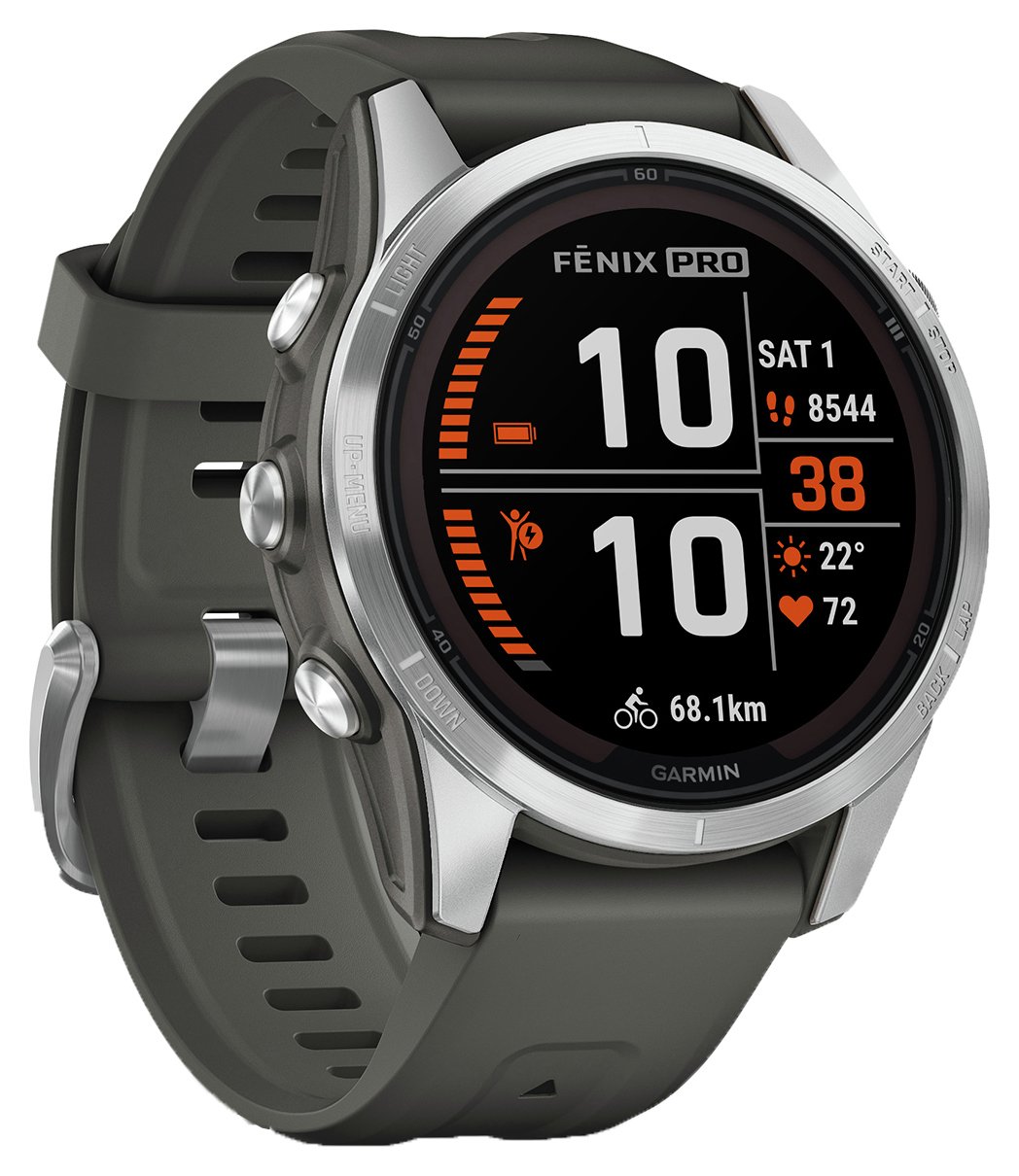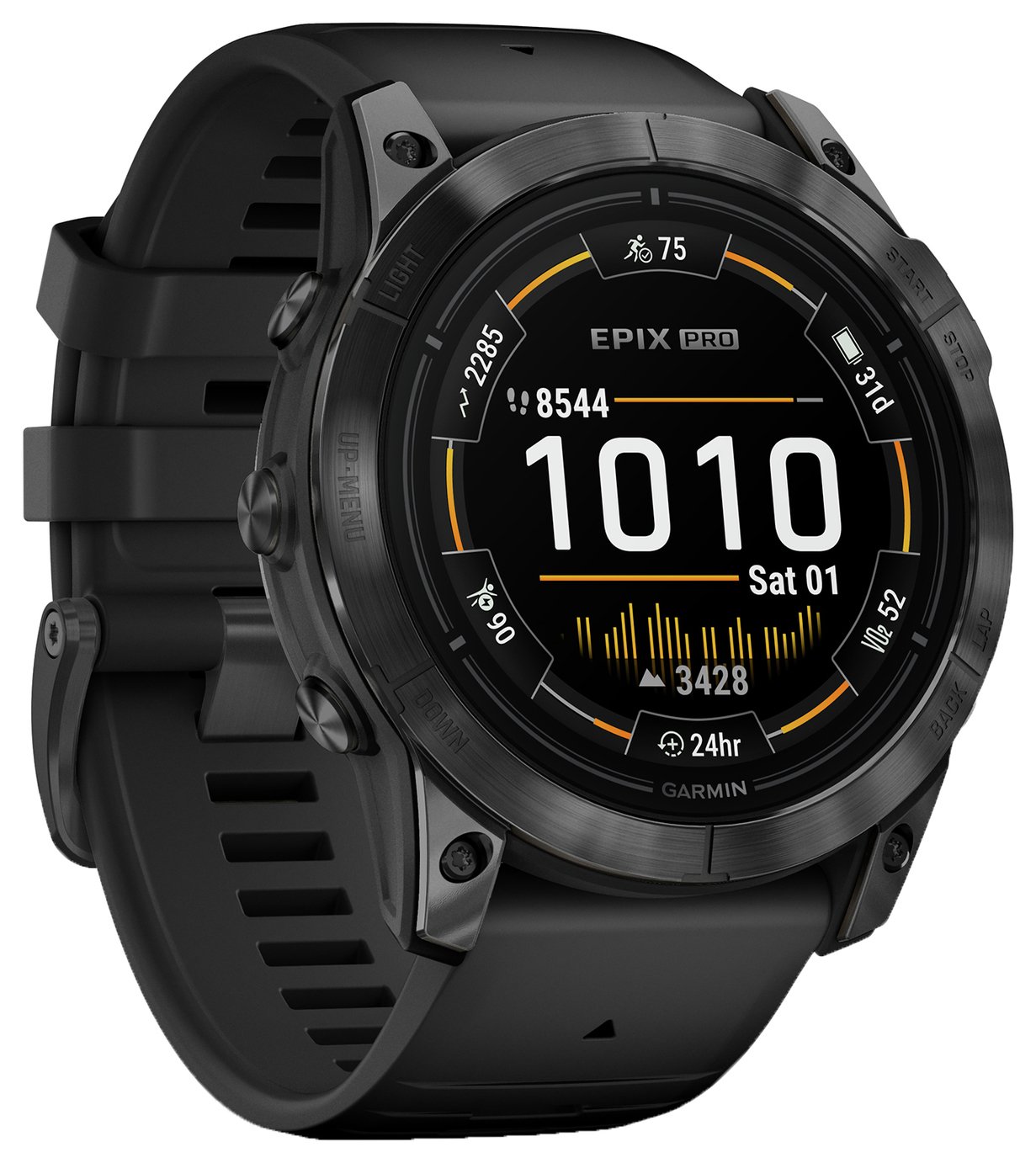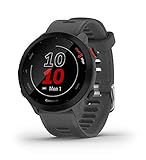Best GPS running watches for performance tracking in 2025
Looking for one of the best running watches to track your progress? Here are our top picks...

Running watches have come a long way since they first came to market. They’ve evolved to become even more intuitive, closely monitoring your activity to create a digital profile of your fitness.
Running watches can sync seamlessly to your phone, giving you access to calls, notifications and music on your wrist. Most models are designed to be worn all-day, with long battery lives and screens that are visible in direct sunlight.
So, for casual runners and serious athletes alike, read on for our picks of the best smartwatches and fitness watches for running in 2025.
If you’re a Garmin fan, we’ve already listed our favourite Garmin watches for runners.
Why you can trust 220 Triathlon
Our team of experts rigorously tests each product and provides honest, unbiased reviews to help you make informed decisions. For more details, see how we rate and test products.
Best running watches at a glance
The Garmin Fenix 7S (buy) has all the features you need for tracking your running and performance, in a high-value, premium and robust build.
The Coros Pace 3 (buy) is a great value, lightweight and dependable running watch, with long battery life and an affordable price tag.
The Polar Grit X Pro (buy) is a hard-wearing, stylish multisport watch with all the activity profiles and tracking necessary for tri training and racing.
The Garmin Epix Gen 2 (buy) offers a huge range of features, tracking, and biometrics, along with accurate run tracking and a top-notch screen.
Best running watches to buy in 2025
Best overall running watch
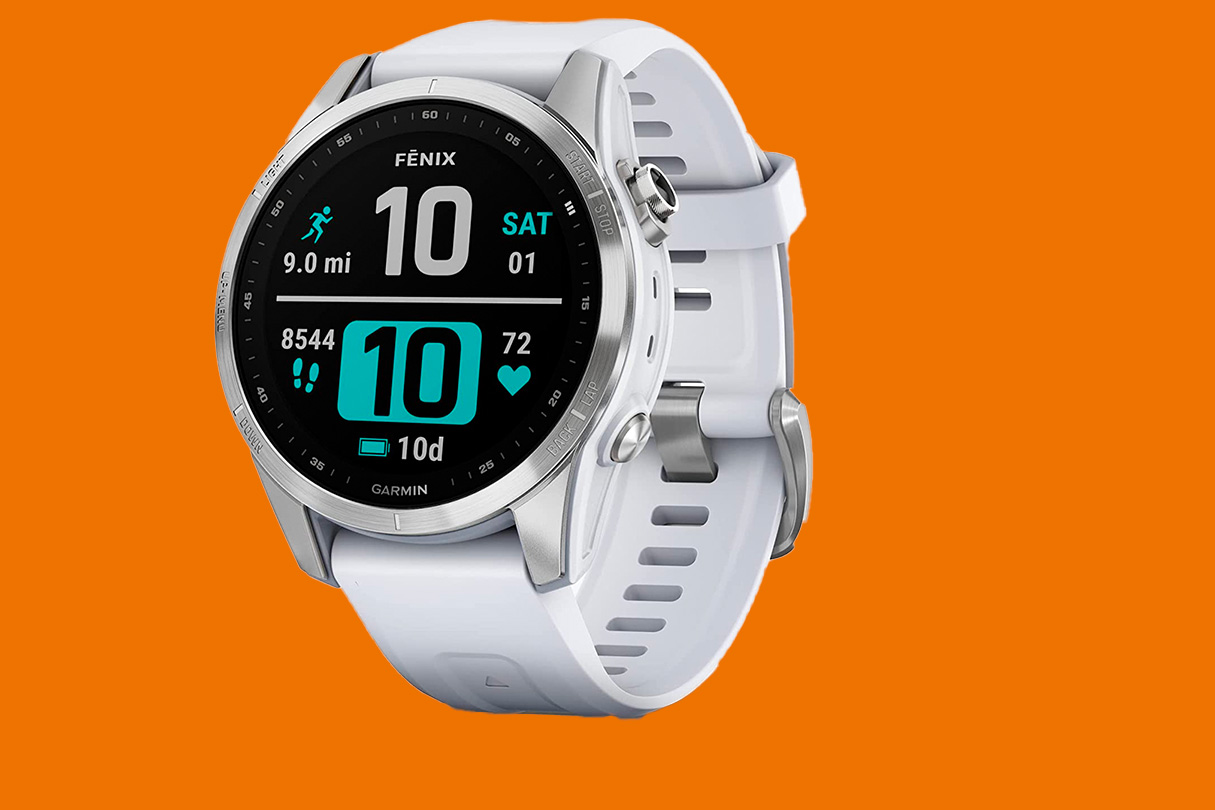
1. Garmin Fenix 7S
220 Triathlon verdict
Arguably the rating should be even higher, but you can’t ignore this is one hefty outlay. Score: 89%
Pros
- Robust, premium build
- Garmin’s software and features is class-leading
Cons
- Price-tag is main drawback
| Price: | $650 / £579.99 |
| Display size: | 1.2″/42mm, 1.9″/47mm, or 2″/51mm diameter |
| Weight: | 2.2oz/63g |
| Battery life: | Up to 11 days in smartwatch mode, up to 37 hours in GPS mode |
| Display type: | touchscreen with buttons |
The Fenix 7S is a smaller-sized, touchscreen fitness watch in Garmin’s popular range of wearable sports tech. The watch has 24/7 health monitoring, covering all bases from heart rate to blood oxygen saturation and sleep.
There’s an impressive amount of tech in the Fenix 7S. The multisport watch, with a battery life of up to 11 days in smartwatch mode and up to 37 hours in GPS mode, has GPS tracking, training features and sports apps.
There are preloaded activities for a number of different sports, and runners will love the advanced performance and training metrics that can track even your trail running adjustment and exertion levels.
Read our full review of the Garmin Fenix 7 Solar to discover more about its features and performance.

2. Suunto Race
220 Triathlon verdict
This is undoubtedly Suunto’s best watch yet for athletes. Score: 88%
Pros
- Full gamut of training features
- Decent mapping and onboard storage
- Impressive app
Cons
- Only pairs with one sensor at a time
- Little else to fault
| Price: | $449/£389 (stainless steel version), $549/£479 (titanium version) |
| Weight: | 2.9oz/83g (stainless steel), 2.4oz/69g (titanium) |
| Battery life: | Up to 16 days smartwatch mode, up to 50 hours with multi-band GPS |
| GPS: | GPS, GLONASS, GALILEO, QZSS, BEIDOU |
| Maps: | Full mapping, plus 16GB (stainless steel) or 32GB storage (titanium) |
The Suunto Race brings plenty to the table when it comes to running features, and is the brand’s top offering for athletes to date.
Its usability shines with a combination of a touchscreen and three physical buttons, paired with a robust set of features.
One key highlight is heart rate variability, a valuable metric that drives several other training tools found on sport watches, including sleep tracking, training stress scores, and monitoring of overall training load.
The watch also includes mapping capabilities, with 16GB of storage on the steel model and 32GB on the titanium version, both easily managed through the intuitive Suunto app.
As expected, it offers an extensive selection of sport profiles to monitor and supports power meters.
Battery performance is remarkable, providing up to 40 hours in GPS mode—more than enough for multiple long workouts, a marathon, or even a full Ironman race.
Read our full Suunto Race review for more.

3. Garmin Enduro 3
220 Triathlon verdict
A brilliant sports watch that justifies the heavy price. Score: 87%
Pros
- Higher spec than predeccessor at lower cost
- More user friendly
- Huge, solar-enhanced battery life
- Loads of features and data
Cons
- Price remains high
- Minimal solar benefit of solar charging in dull conditions
- Screen isn’t AMOLED
| Price: | $899.99 / £769.99 |
| Weight: | 2.2oz/63g |
| Screen: | 1.4in/35.5mm, 280 x 280 pixels |
| Features: | Route suggestions, HRV tracking, flashlight, solar charging, Garmin Pay, multi-band GPS, music storage, Training Readiness metric |
| Battery life: | 320 hours (claimed) |
The Garmin Enduro 3 stands out in the smartwatch area as a next-gen multisport watch that comes in at a lower price than the model it replaces, which is pretty unusual.
Priced at $900 (£770), it’s admittedly still a high-end investment, but its solar-boosted battery life (rated up to 320 hours in GPS mode) is unparalleled, though maximum juice is only achievable under strong sunlight.
A larger solar ring has been added without compromising screen brightness. The display is easier to read than on the Enduro 2, though it still lags behind AMOLED competitors in sharpness.
The Enduro 3 comes fully loaded with performance upgrades, including a more accurate heart rate monitor, advanced strength training support, an improved interface, a built-in flashlight, and intelligent navigation features like ClimbPro.
Tailored for endurance-focused athletes, particularly cyclists and long-distance runners, the Enduro 3 also includes extras like music playback, Garmin Pay, and stock market updates. It’s an excellent all-around performer, just don’t count on peak battery life in overcast conditions.
Read our full review for the Garmin Enduro 3 here.

4. Coros Pace Pro
220 Triathlon verdict
Fine watch in the price point where Coros shines. Score: 87%
Pros
- Lovely screen resolution
- Improved hardware and software
- Good value
Cons
- Diminished battery life compared to Pace 3
- Cheap-looking strap
- Doesn’t support music streaming apps
| Price: | $349 / £349 |
| Weight: | 1.3oz/37g |
| Screen: | 1.3inch AMOLED |
| Features: | Offline colours maps, HRV measurement, training effect and load tracking, race-time predictor and virtual pacer, triathlon mode, sleep tracking |
| Battery life: | Up to 31 days |
Coros has finally joined the AMOLED game with the Pace Pro, and it’s a welcome leap. The vibrant 1.3in display is a joy on dark runs, and triathlon features are well covered with modes for swim, bike, run, and strength.
Upgrades include a faster processor, improved GPS and heart-rate accuracy, and full-colour offline maps – though you’ll have to self-reroute if you stray off-course.
Storage jumps from 4GB to 32GB, and battery life holds up well despite the bright screen. Downsides? The silicone strap feels a bit basic, and music is MP3-only. Still, it’s a solid all-rounder for runners and multisport athletes.
Read our full Coros Pace Pro review for more.

5. Polar Vantage M3
220 Triathlon verdict
Similar to its siblings but much more affordable. Score: 86%
Pros
- Crisp screen
- Competitive price
- Sophisticated features
- Uses identical software to Polar’s pricier mdoels
Cons
- Polar Flow app is due an upgrade
- Battery life isn’t the longest
| Price: | $399 / £349 |
| Weight: | 1.9oz/53g |
| Screen: | 1.28inch AMOLED |
| Features: | Dual-frequency GPS, offline maps, wrist-ECG readings |
| Battery life: | 30 hours of training time (claimed) |
The Polar Vantage M3 delivers high-end triathlon watch features without the premium price tag. It shares the same software as the pricier Vantage V3 and Grit X2 Pro, offering dual-band GPS, an AMOLED screen, offline maps, HRV tracking, and wrist-based running power.
At just 1.9oz/53g, it’s noticeably lighter, though its plastic build and smaller 1.28in display reflect the cost-saving design.
Battery life tops out at 30 hours (or 15 with always-on display), which is decent but less than its siblings. While the Polar Flow app feels dated, the M3’s performance-focused features make it a smart pick for serious triathletes on a budget.
Read our full Polar Vantage M3 review for more.

6. Polar Grit x2 Pro
220 Triathlon verdict
Quality watch but not perfect; excessive price. Score: 75%
Pros
- In-depth recovery data
- Feels a premium watch
Cons
- Calibration feature is a faff to use
- Lacks accuracy in open water conditions
| Price: | $749.95 / £649 |
| Weight: | 2.8oz/79g (including wristband) |
| Display size: | 35.3mm (1.39in) diameter |
| Battery life: | Up to 10 days smartwatch mode, up to 43 hours in performance training mode |
| Display type: | AMOLED |
The Polar Grit X2 Pro is a rugged, feature-packed watch built for serious runners, triathletes, and outdoor athletes. It shares much with the Vantage V3 but adds a tougher stainless-steel shell and crystal-clear AMOLED display.
GPS tracking is excellent on land, though open-water performance and calibration quirks leave room for improvement. With 150+ sport modes, offline maps, cycling metrics like VAM, and useful features like FuelWise, it’s a solid training tool.
However, the lack of TrainingPeaks integration and steep $750/£650 price tag may raise eyebrows, especially with rival watches offering similar features for less. A strong performer, but not without flaws. Also on test is the original Polar Grit X watch, which we’ve rated highly.
Check out our full Polar Grit X2 Pro review for more.
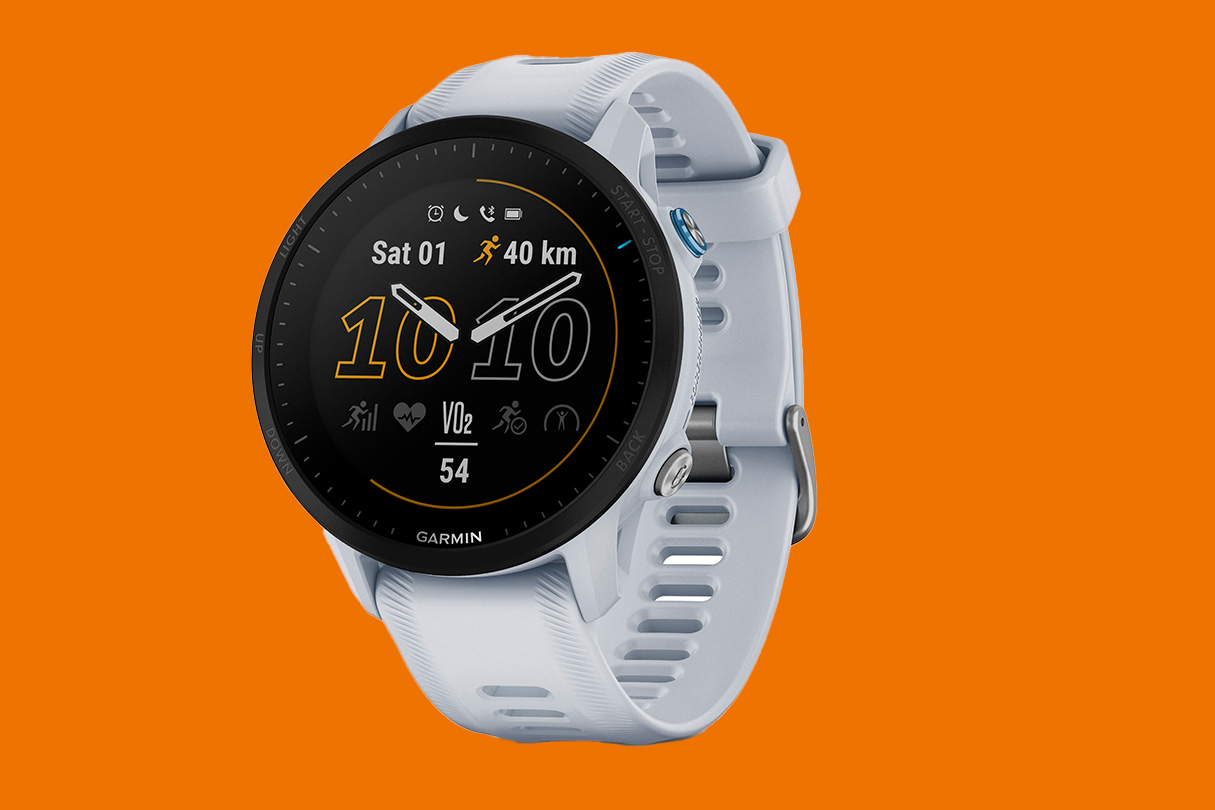
7. Garmin Forerunner 955 Solar
220 Triathlon verdict
Well-thought-out upgrade that lasts longer than ever. Score: 87%
Pros
- Feels lightweight on wrist
- Excellent gamut of performance features
Cons
- Doesn’t feel quite as premium as the Fenix 7
- Rather high price tag
| Price: | $599.99 / £519.99 |
| Weight: | 1.8oz/52g |
| Screen: | 1.4in/35.5mm, 280 x 280 pixels |
| Battery life: | Up to 20 days smartwatch mode, up to 80 hours with GPS only |
The Garmin Forerunner 955 Solar uses solar charging to deliver a massive battery life of up to 20 days in smartwatch mode. The watch has a well-lit touchscreen that promises to be highly responsive, as well as traditional on-the-side buttons for those who prefer them.
The multisport watch includes advanced health monitoring (including VO2 max, heart rate variability, sleep, recovery), smart features and activity tracking.
Additional features that are perfect for runners include running power (when using a compatible device), Training Readiness, suggested workouts, PacePro (which helps you stay at your desired pace) and full-colour built-in mapping.
Up to 2,000 songs can also be downloaded onto the watch, which can be connected to your headphones for phone-free listening.
Read our full review of the Garmin Forerunner 955 Solar.
Best budget running watch

8. Coros Pace 3
220 Triathlon verdict
Coros does it again – another budget masterpiece. Score : 86%
Pros
- Exceptional value for money
- Great battery life
Cons
- No mapping
- Screen may be too small for some
| Price | $229 / £219 |
| Weight | 1.05oz / 30g |
| Battery life | 15 days everyday use / 38 hours GPS mode |
| Display | 1.2in / 4.19cm |
The third version of the Coros Pace lineup is another notable release and great news for athletes seeking budget-friendly gear.
This edition keeps the familiar single button and rotating dial, but introduces a touchscreen, which is a welcome addition.
With its lightweight design at just 30g (only 1g more than its predecessor) and compact 1.2-inch display, it feels barely noticeable on your wrist.
The LCD screen is reasonably good, and the battery performance is impressive, offering 38 hours in GPS mode or up to 30 days in standard use.
Although it lacks full maps, it provides turn-by-turn directions and a breadcrumb trail for navigation. However, we found creating routes in the Coros app to be a bit challenging.
You can select from 20 activity profiles, including triathlon and various swim, bike, and run combinations. It also offers 4GB of internal storage for music.
Read our full Coros Pace 3 review here.
Best high-end running watch

9. Garmin Epix Gen 2
220 Triathlon verdict
Take the Fenix, add a brilliant new screen and you end up with the Epix Gen 2. Score : 92%
Pros
- Fantastic screen
- Huge range of features
Cons
- Insane price
- May be too chunky for some
| Price | $799.99 / £899.99 |
| Weight | 2.7oz / 76g |
| Battery life | Up to 16 days everyday use / 28 hours GPS mode |
| Display | 1.9in/47mm (also 42mm and 51mm), AMOLED, 454×454 pixels |
A powerhouse watch with a price tag to match, the Epix Gen 2 delivers premium performance for runners, with all of Garmin’s top-tier features.
It boasts a wide range of sport profiles (including triathlon), along with tools like Training Status, Training Load, and Real-Time Stamina tracking.
Housed in a rugged and sizable design (there is a choice of case size though), it doesn’t skimp on style, thanks to its stunning AMOLED display. The screen offers exceptional clarity, vibrant colors, impressive brightness, and a spacious viewing area.
However, the inclusion of this high-quality display does impact battery life, which, while still solid, isn’t as long-lasting as some of Garmin’s other flagship models. It provides up to 42 hours in GPS mode and a maximum of 16 days in standard use.
See our full Garmin Epix Gen 2 review for more.

10. Garmin Forerunner 945
220 Triathlon verdict
The most complete triathlon watch we’ve used to date at the time of testing. Score: 92%
Pros
- Detailed training analysis
- Decent screen and battery life
Cons
- Getting a little old now
- Blips in GPS accuracy when in water
| Price: | $599.99 / £499.99 |
| Weight: | 1.8oz/50g |
| Screen: | 1.2in/30.4mm, 240×240 pixels |
| Battery life: | Up to 14 days smartwatch mode, up to 36 hours in GPS mode |
The Garmin Forerunner 945 can closely track your activity and performance, being able to detect when you’re training productively, peaking or overtraining.
The smartwatch’s navigation is tailored for runners. It’s designed to be seen at a glance, and the map can provide navigation when you’re road running and when you go off path.
See our full review of the Garmin Forerunner 945 here.
Best watch for multisport adventures

11. Polar Grit X Pro
220 Triathlon verdict
Great multisport watch that’s built to be durable and techy. Score : 87%
Pros
- Multisport watch with lots of sport profiles
- Stuffed full of tech and durability features
Cons
- Watch face may be too large for small wrists
- Weighty price tag
| Price: | $559.95 / £484 |
| Weight: | 2.8oz/79g (including wristband) |
| Display size: | 1.2in/47mm diameter |
| Battery life: | Up to 7 days smartwatch mode, up to 40 hours in performance training mode |
| Display type: | AMOLED, 240×240 pixels |
The Grit X Pro is a great choice if you’re looking for durability, as Polar promises that the fitness watch is built for adventurers. Precise heart rate monitoring, activity tracking, 100m water resistance and a training guide make this a stand-out watch for runners.
Battery life is around 40 hours in GPS-mode and there are a range of physical fitness tests. These include a VO2 max test, a leg-recovery test and an orthostatic test based on heart rate and heart rate variability data. There’s also turn-by-turn directions with a basic breadcrumb-style map
Read our full Polar Grit X Pro review here.
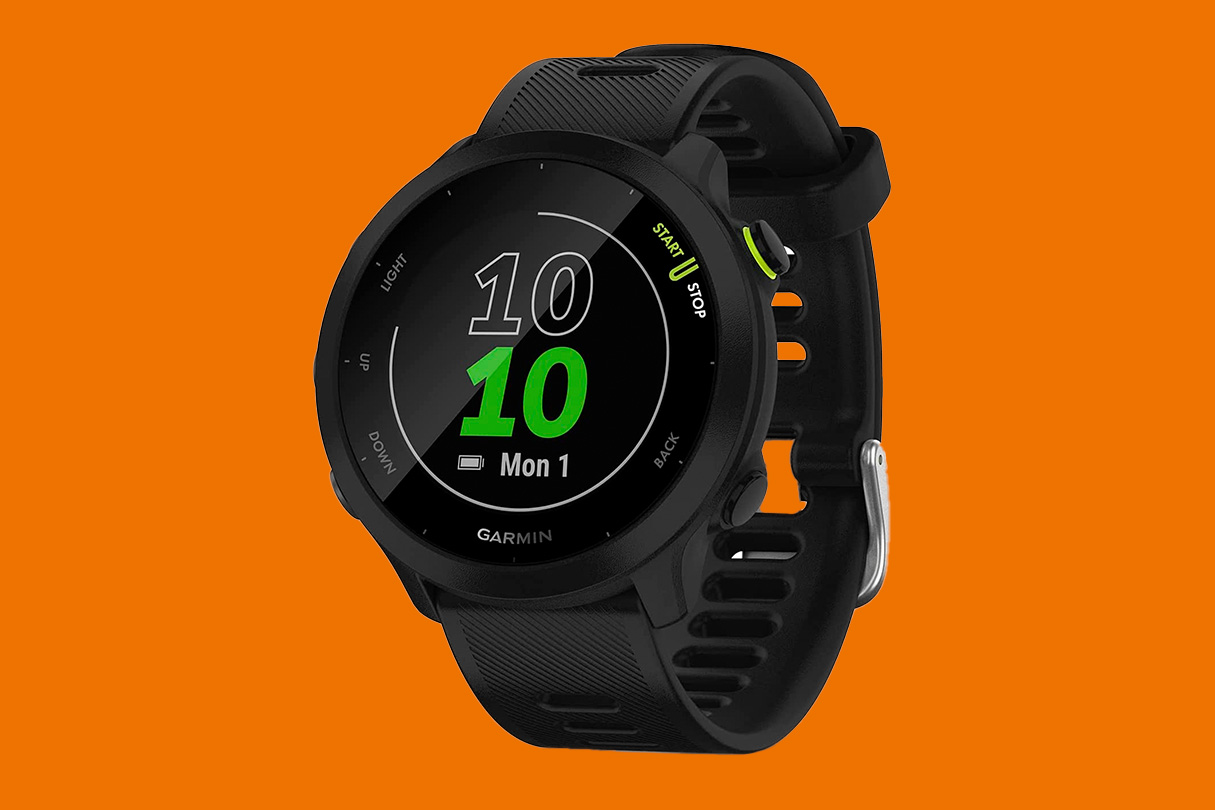
12. Garmin Forerunner 55
220 Triathlon verdict
A simple and easy-to-use smartwatch, with the reliability and quality that comes with a Garmin. Score : 80%
Pros
- Slimline, simple, and affordable
- All the key sport features
Cons
- Doesn’t have the same tech as others
| Price: | $199.99 / £179.99 |
| Weight: | 1.3oz/37g (including wristband) |
| Display size: | 1.04in/26.3mm diameter |
| Battery life: | Up to 14 days smartwatch mode, up to 20 hours in performance training mode |
| Display type: | MIP |
If you’re in the market for an easy-to-use running watch that won’t break the bank, the Forerunner 55 is worth considering.
Unlike some higher-end Garmin models featured in this lineup, it doesn’t include a touchscreen, built-in music storage, or contactless payment options. It’s also only 37g, though, bringing on similar ground to the Coros Pace 3 when it comes to weight.
However, the Forerunner 55 compensates for its lack of advanced features with a 14-day battery life, a waterproof design, and a variety of health monitoring tools.
It supports tracking for multiple sports, including running, and provides insights on calories burned, breathing, hydration, sleep patterns, and menstrual cycle tracking. It also offers recovery tips and pregnancy monitoring.
For those who need workout tunes, you can play music via your phone and control playback directly from the watch.
How we tested
The smartwatches reviewed here have been carefully tested with a focus on running capabilities by 220 Triathlon’s experienced gear testers, who collectively have over 50 years of expertise evaluating sports and outdoor equipment.
Each watch underwent at least a month of rigorous testing, with many being used extensively for even longer periods.
During testing, we took the watches on numerous runs of varying intensity, including intervals, long-distance runs, and recovery sessions, to assess their ability to handle changes in pace and heart rate tracking.
The tests spanned diverse environments—urban areas, open countryside, and forest trails—to evaluate GPS performance and accuracy. Recorded routes were compared against other devices and meticulously analyzed on a map to ensure reliability.
Heart rate accuracy was benchmarked against our standard chest-based heart rate monitor, providing a reliable baseline for comparison.
In addition to run-specific metrics, we assessed battery life during extended use, the watch’s ease of operation, the quality of its companion app, and how seamlessly it integrates into daily life.
What to look for in a running watch

GPS accuracy
Reliable GPS signal is essential for tracking distance, pace, and route. Look for running watches that capture signal and perform well in various environments, including urban areas and trails.
Heart rate and biometrics
Opt for a watch with accurate wrist-based heart rate tracking, or the ability to pair with chest HR straps for more precise data. All of our recommended watches on test provide accurate heart rate monitoring.
Battery life
Consider the battery’s longevity, especially for longer runs. GPS mode and biometrics tracking drain more power, so ensure it meets your training and racing needs.
Comfort and fit
Comfort comes down to personal preference. Look out for watch face sizes and strap lengths, matching with your wrist size. Lightweight watches tend to be more comfortable, especially if you’re using sleep tracking.
Training-specific features
Run training features could include interval timers, training load score, VO2 max analysis, and recovery suggestions. All of these aim to give you the tools to optimise your run performance.
Connectivity and synching
A good companion app makes it easier to analyze your runs, set goals, and track progress over time. Ensure compatibility with your preferred platform, most watch brands these days will have a free companion app that also syncs to apps like Strava.
Durability
Choose a running smartwatch that can withstand sweat, rain, and the occasional scratch and drop onto the floor, with a water-resistant rating suitable for outdoor use. Some watches will have additional durability features, like the indestructible, sapphire-cased watches.
Take a look at our best triathlon watches article for more.

